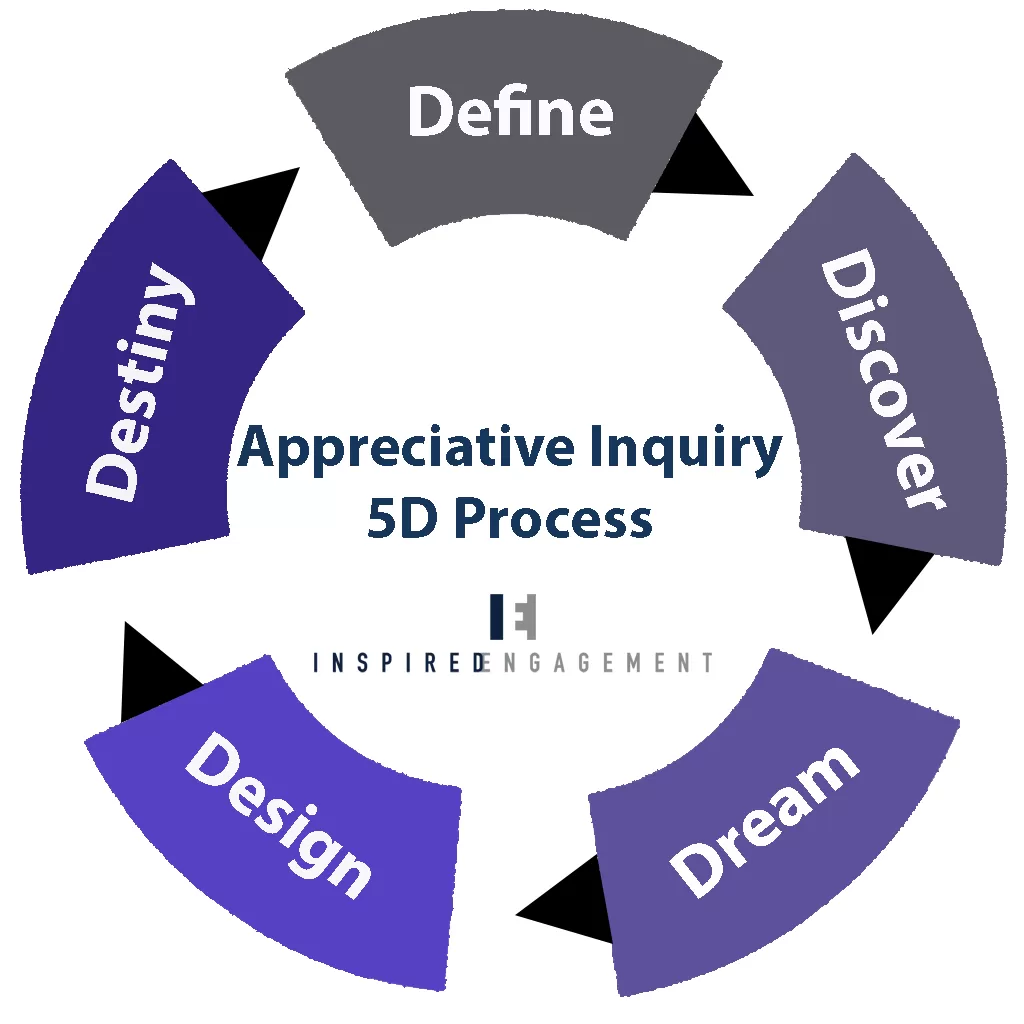Building the Future Through Strengths
Most organizations know how to run a meeting about what’s broken.
Fewer know how to systematically create conversations focused on what gives life, energy, engagement — and then build a future based on that.
That’s what Appreciative Inquiry does.
Appreciative Inquiry (AI) is an energizing and inclusive process that fosters creativity through the art of positive inquiry and helps create shared vision and purpose by building on core values and strengths — not deficiencies.
Appreciative Inquiry is used globally in strategic planning, organizational culture work, campus-wide initiatives, team development, community engagement, and leadership alignment.
At Inspired Engagement — we use the Appreciative Inquiry process because it drives action, creates commitment, and delivers results that stick.
Why Appreciative Inquiry Works
APPRECIATIVE INQUIRY deliberately shifts the focus of organizational conversation — from problem fixation → to opportunity exploration.
It is grounded in positive psychology, emotional intelligence, and the human sciences — and grows stronger organizations by studying what works, where energy exists, and what success looks like at its best.
The Appreciative Inquiry process doesn’t try to “fix” people.
It invites people to build the future they want to live in.
It replaces problem investigation with innovation.
It replaces “what went wrong” with “what gives life here?”
And that shift of attention — creates a shift of energy.
The Appreciative Inquiry 5-D Cycle Explained
The Appreciative Inquiry process moves through five core phases:
Phase | What Happens |
Define | Choose the affirmative topic for the inquiry |
Discover | Explore high points and stories of success |
Dream | Imagine a desired, preferred future |
Design | Innovate ways to move toward that future |
Destiny | Lean into the design and learn as you go |

APPRECIATIVE INQUIRY is cyclical — not linear. The work doesn’t stop; it becomes a cycle of continuous improvement.
What Appreciative Inquiry Looks Like in Practice
Whether we do it in-person or 100% virtually — the backbone of Appreciative Inquiry is the appreciative interview: people interviewing each other using structured questions about their best experiences, their values, and their hopes for the future.
For example — when Inspired Engagement facilitated a virtual Appreciative Inquiry with Gateway Technical College — over 248 faculty participated across multiple Zoom accounts, using guided interviews, breakout rooms, and real-time Google Docs to gather themes and create action plans that led to the creation of a college Faculty Teaching and Learning Caucus.
This wasn’t theoretical.
It was a large-scale, 250-person, campus-wide co-creation.
The same pattern repeated in other Inspired Engagement projects — including:
- Phoenix College Shared Governance Summit (used to build clarity, transparency, and mutual trust around decision-making)
- Rend Lake College Strategic Plan (2021-2024) — where over 175 stakeholders contributed to shaping the future by sharing stories of student success, engagement, effective communication, and exemplary leadership
- Scottsdale Public Libraries culture and futures planning — exploring core values, future visioning, community connection, technology, access, and the evolving role of libraries
Different institutions.
Different industries.
Different challenges.
The process worked — because it invited the system to design its own future.
Appreciative Inquiry vs Brainstorming
This is important.
Appreciative Inquiry is not brainstorming.
Brainstorming is about generating ideas quickly.
Appreciative Inquiry is about generating energy, alignment, purpose, and commitment — by rooting the conversation in lived success.
The data that drives Appreciative Inquiry is human experience.
The leverage points come from the stories.
When you ask people to describe a time they were at their best — you learn:
- what created engagement
- what behaviors supported success
- what the shared DNA of excellence looks like
- what motivates people to take ownership
You don’t get that from problem lists.
You only get that from appreciative questions.
What Appreciative Inquiry Builds Inside Organizations
Three internal muscles consistently strengthen when an organization engages in Appreciative Inquiry:
- Trust – When people are listened to — and their stories become the strategic raw material — trust rises.
- Psychological Ownership People support what they help create. APPRECIATIVE INQUIRY builds shared accountability in a way top-down directives never will.
- Forward Momentum People move toward their image of the future. As Cooperrider notes — image inspires action — and communities evolve toward the pictures they hold of themselves.
When you improve the image — you accelerate performance.
Appreciative Inquiry Works for Planning and Culture Change
Many organizations only come to APPRECIATIVE INQUIRY for strategic planning.
That’s fine — but it undersells its value.
In practice — Appreciative Inquiry is one of the most elegant, humane, repeatable approaches to culture building in existence.
We’ve used APPRECIATIVE INQUIRY for:
- planning
- shared governance alignment
- strengths-based culture building
- leadership retreats
- team re-set conversations
- community engagement
- strategic intention setting
- cross-college change
And in every case — the reason it works is the same:
People don’t resist change — they resist being changed.
APPRECIATIVE INQUIRY doesn’t impose change.
It amplifies what already works and expands what people care about most.
Appreciative Inquiry helps teams — at scale — move toward the future they want.
It is strategic.
It is grounded in research.
It is emotionally intelligent.
And it produces practical action — not just inspiration.
Take the Next Step
If your team is ready to:
- elevate morale
- strengthen trust
- clarify purpose
- create shared priorities
- move beyond “problem-fixing” culture
…then Appreciative Inquiry is likely the right starting point.
Because once people see what is possible — they commit differently.
They show up differently.
They create differently.
Want to bring Appreciative Inquiry into your organization — virtually or in person?
Contact us for a Free Consultation. Get Started

